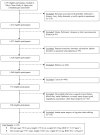Normative spatiotemporal gait parameters in older adults
- PMID: 21531139
- PMCID: PMC3104090
- DOI: 10.1016/j.gaitpost.2011.03.024
Normative spatiotemporal gait parameters in older adults
Abstract
While factor analyses have characterized pace, rhythm and variability as factors that explain variance in gait performance in older adults, comprehensive analyses incorporating many gait parameters have not been undertaken and normative data for many of those parameters are lacking. The purposes of this study were to conduct a factor analysis on nearly two dozen spatiotemporal gait parameters and to contribute to the normative database of gait parameters from healthy, able-bodied men and women over the age of 70. Data were extracted from 294 participants enrolled in the Mayo Clinic Study of Aging. Spatiotemporal gait data were obtained as participants completed two walks across a 5.6-m electronic walkway (GAITRite(®)). Five primary domains of spatiotemporal gait performance were identified: a "rhythm" domain was characterized by cadence and temporal parameters such as stride time; a "phase" domain was characterized by temporophasic parameters that constitute distinct divisions of the gait cycle; a "variability" domain encompassed gait cycle and step variability parameters; a "pace" domain was characterized by parameters that included gait speed, step length and stride length; and a "base of support" domain was characterized by step width and step width variability. Several domains differed between men and women and differed across age groups. Reference values of 23 gait parameters are presented which researchers or clinicians can use for assessing and interpreting gait dysfunction in aging persons.
Copyright © 2011 Elsevier B.V. All rights reserved.
Conflict of interest statement
None of the authors has a financial or personal relationship with people or organizations that could inappropriately influence this work.
Figures


References
-
- Ferrucci L, Baldasseroni S, Bandinelli S, de Alfieri W, Cartei A, Calvani D, Baldini A, Masotti G, Marchionni N. Disease severity and health-related quality of life across different chronic conditions. J Am Geriatr Soc. 2000;48:1490–1495. - PubMed
-
- Cesari M, Kritchevsky SB, Penninx BWHJ, Nicklas BJ, Simonsick EM, Newman AB, Tylavsky FA, Brach JS, Satterfield S, Bauer DC, Visser M, Rubin SM, Harris TB, Pahor M. Prognostic value of usual gait speed in well-functioning older people--results from the Health, Aging and Body Composition Study. J Am Geriatr Soc. 2005;53:1675–1680. - PubMed
-
- Studenski S, Perera S, Wallace D, Chandler JM, Duncan PW, Rooney E, Fox M, Guralnik JM. Physical performance measures in the clinical setting. J Am Geriatr Soc. 2003;51:314–322. - PubMed
-
- Maki BE. Gait changes in older adults: predictors of falls or indicators of fear. J Am Geriatr Soc. 1997;45:313–320. - PubMed
Publication types
MeSH terms
Grants and funding
LinkOut - more resources
Full Text Sources
Other Literature Sources
Medical

